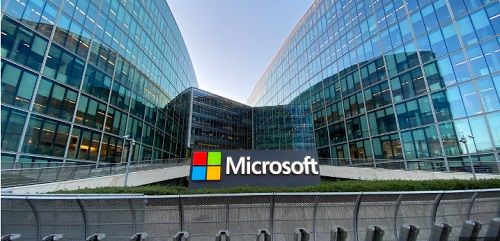Thousands of businesses in the UK may receive compensation if a legal action against tech giant Microsoft is successful.
Regulatory expert Dr. Maria Luisa Stasi is accusing the tech behemoth of overcharging companies for its Windows Server software, which is used in cloud computing. She is pursuing compensation exceeding £1bn on behalf of UK companies. The BBC has reached out to Microsoft for a response.
The lawsuit is organized on an “opt-out” basis, meaning that all UK organizations are initially represented unless they choose not to participate.
This case represents the latest class action lawsuit filed at the UK’s Competition Appeal Tribunal against major tech companies, with Facebook, Google, and mobile phone firms also facing other legal actions.
Such claims remain relatively new in the UK, as they were introduced in 2015, so there is limited precedent to gauge the likelihood of success—although the outcome may take several years to materialize.
This development coincides with the UK’s Competition and Markets Authority (CMA) investigating the cloud computing sector in the UK.
In general, cloud computing refers to data that is stored online and can be accessed from any location at any time.
It plays a crucial role in the functioning of the modern world, with applications ranging from vast data storage to video and music streaming.
Cloud computing has become essential for how many businesses operate today.
Typically, this involves either using Microsoft’s Azure platform or forming agreements with other providers like Amazon and Google, who may then license software from Microsoft.
The dispute over licensing is at the heart of the controversy, with Google informing the CMA in June: “We believe Microsoft’s licensing practices both raise rivals’ costs and weaken rivals’ ability to compete for a significant proportion of customer demand.”
Microsoft has firmly rejected these claims, stating in its response to the investigation in July that its licensing terms “do not meaningfully raise cloud rivals’ costs.”
The legal claim filed today asserts that “many thousands” of UK businesses may have been impacted.
It contends that small enterprises are “particularly hard-hit,” citing Office for National Statistics data indicating that more businesses closed than were established in 2022.
“In simple terms, Microsoft is penalizing UK businesses and organizations for utilizing Google, Amazon, and Alibaba for cloud computing by forcing them to pay more for Windows Server,” Ms. Stasi stated.
“By doing this, Microsoft seeks to push customers toward using its Azure cloud service and limit competition in the sector.
“This lawsuit intends to challenge Microsoft’s anti-competitive conduct, compel them to disclose the extent to which UK businesses have been illegally overcharged, and return those funds to organizations that have been treated unfairly.”
Stasi represents customers of Amazon, Google, and Alibaba but does not represent any of those companies, her spokesperson informed CNBC.
The CMA is preparing “behavioral” remedies that address anti-competitive practices in the cloud sector following a months-long investigation, with two sources informing CNBC last month that a provisional decision could be expected as early as this week.
The CMA has chosen not to comment on the specific timing of its provisional decision. However, it has previously set a deadline of November to December 2024.
Earlier this year, Microsoft reached a settlement of 20 million euros ($21 million) with the cloud trade body CISPE and its members, resolving an EU antitrust complaint that accused the tech giant of unfair software licensing practices within its cloud division.
As part of this agreement, Microsoft consented to charge companies the same price for using its software on smaller cloud providers’ systems as it does on its own Azure platform.
However, in September, Google lodged a new antitrust complaint against Microsoft with the European Commission, which is the executive body of the EU.
The complaint alleged that Microsoft’s software licensing terms effectively bind businesses to its Azure platform and complicate the process of switching providers, thereby tightening its control over the cloud market.
Solange Viegas Dos Reis, chief legal officer of the French cloud company OVHCloud, told CNBC that some cloud hyperscalers are essentially “selling two products that should be completely separate” — commonly used software and cloud infrastructure.
There’s also the issue of hyperscalers providing more functionalities of their software when it operates on their own cloud services compared to third-party cloud services, Dos Reis noted without specifying any particular vendor.
From 2017 to 2022, European cloud firms experienced a decline in market share, dropping from 27% to 13%, while the overall European cloud market grew fivefold to reach 10.4 billion euros ($11 billion), as reported by Synergy Research Group.
The topic of software licensing in the cloud remains one that has not been previously evaluated, Dos Reis mentioned in a CNBC interview last week, adding that OVH has “a lot of hope” regarding the CMA’s actions.
What was the Microsoft Antitrust Case?
The antitrust case involving Microsoft emerged as one of the most prominent legal battles a few decades ago. In the 1990s, U.S. federal regulators filed a lawsuit against Microsoft, which was then the leading software company globally. The Federal Trade Commission initiated an inquiry in response to Microsoft’s increasing dominance in the personal computer market.
The purpose of the investigation was to assess whether Microsoft was attempting to monopolize the personal computer sector. The federal agency concluded its inquiry, but the U.S. Department of Justice resurrected the issue in 1998.
The Justice Department initiated antitrust proceedings against the software giant. These charges arose from Microsoft’s practice of bundling extra applications with its operating system, meaning customers wishing to use a specific Microsoft application had to purchase the Microsoft Windows operating system.
Additionally, Microsoft provided its browser software, Internet Explorer, to consumers without charge. This strategy led to a concentration of market share, ultimately contributing to the decline of Netscape, Microsoft’s main competitor at the time. The Department of Justice claimed that Microsoft purposefully made it extremely challenging for consumers to install competing software on personal computers that utilized Microsoft’s operating system.
What Exactly Are Antitrust Laws?
Antitrust laws are established by governments to promote fair competition in the marketplace. These laws ban practices that negatively affect free markets and create obstacles to entry. Common examples include industry-wide price-fixing, anti-competitive corporate mergers, and predatory pricing intended to sustain monopoly power.
The primary goal of antitrust laws is to safeguard consumers from the adverse effects of market monopolies, which often manifest as higher prices for goods and services. Many companies attempt to evade legal repercussions by establishing themselves as market leaders and forming monopolies through acquisition or elimination of competition.
In the U.S., antitrust laws were instituted by the Sherman Antitrust Act of 1890. This groundbreaking legislation prohibited trusts, cartels, and similar arrangements.
The Outcome
Microsoft lost its case against the government, with Judge Thomas Penfield Jackson declaring that the company breached several provisions of the Sherman Antitrust Act. However, the trial faced numerous challenges, including false and misleading testimonies, evidence tampering involving executive emails, and various courtroom distractions.
During that period, Microsoft was regarded as one of the major innovators, and CEO Bill Gates was seen as exceptionally brilliant. Additionally, a significant number of economists argued that antitrust laws not only hinder innovation but also adversely affect consumers.
A key argument from those defending Microsoft was that antitrust laws impede the success of domestic companies on a global scale, making them less competitive. This concern arose because most countries, except for those in the European Union, do not impose rigorous national antitrust regulations.
The Legal Proceedings
Microsoft was formally accused of establishing a market monopoly by making it harder for users to install competing software while simultaneously complicating the uninstallation process of its browser, Internet Explorer.
The company contended that these practices were voluntary and that consumers had the freedom of choice thanks to alternatives like Macintosh and Unix. The government found that by suppressing competition, Microsoft posed a threat to innovation within the software sector. Consequently, the company was required to share its data with other third parties.
Microsoft expressed strong disapproval of the ruling, claiming bias favoring the prosecution.
Splitting Up Big Tech
The government ruled that Microsoft should be divided into two distinct entities, one focused solely on the Windows operating system and the other managing all other software products created by Microsoft.
Microsoft contested this ruling, and an appeals court reversed the decision. However, it established a precedent that resonates in current discussions advocating for the breakup of big tech among progressive U.S. politicians. For instance, numerous lawmakers propose that Amazon be divided into two separate entities, one for e-commerce and the other for Amazon Web Services.
Consequences of the Ruling
Even with the noted decline in the enforcement of antitrust laws in the U.S. recently, the Microsoft case played a pivotal role in fostering a market environment conducive to the rise of major companies today, such as Google and Apple.
Revenue from Azure and other cloud services was up 33%, surpassing estimates
Microsoft announced a better-than-expected earnings and revenue report for the first quarter of the fiscal year on Wednesday, but the stock fell 4% in after-hours trading following a forecast that indicated slower growth than anticipated.
Here’s how the company fared compared to analysts’ predictions based on a survey conducted by LSEG:
- Earnings per share came in at $3.30, exceeding the expected $3.10.
- Revenue reached $65.59 billion, surpassing the anticipated $64.51 billion.
- The revenue grew by 16% year over year for the quarter ending September 30, according to a statement.
- Net income increased by 11% to $24.67 billion from $22.29 billion in the same quarter last year.
For the ongoing quarter, Microsoft projected revenue to be between $68.1 billion and $69.1 billion. This range suggests a 10.6% growth in the middle of the forecast. Analysts surveyed by LSEG expected revenue of $69.83 billion.
Due to delays from external suppliers in delivering data center infrastructure, Microsoft anticipates not being able to satisfy demand in the upcoming fiscal second quarter.
“I am optimistic that by the second half of this fiscal year, the supply and demand will align better,” CEO Satya Nadella stated during a conference call with analysts.
In August, Microsoft announced plans to revise how it reports business segments to align better with its management strategy. Revenue from mobility and security services, along with certain Windows revenue, is now part of the productivity and business processes unit, which encompasses Office software.
Revenue from productivity and business processes grew by 12% to $28.32 billion in the quarter, exceeding the $27.9 billion consensus among analysts who were surveyed by StreetAccount. This figure is 38% higher than the $20.45 billion midpoint forecasted by management in July due to adjustments in the accounting.
Investors gained greater insight into Microsoft’s cloud computing usage. For the first time, the revenue growth metric for Azure and other cloud services excludes mobility and security, as well as Power BI data analytics sales. Azure growth for the quarter was reported at 33%, or 34% when accounting for constant currency, with 12 points driven by artificial intelligence services. Consensus estimates for Azure growth were 32.8% according to CNBC, while StreetAccount estimated 29.4%.
“There is still a significant demand that exceeds our capacity,” said Amy Hood, Microsoft’s finance chief, during the call.
Hood projected Azure growth at constant currency for the fiscal second quarter to be between 31% and 32%.
The overall intelligent cloud segment, which includes Azure, Windows Server, and enterprise services, brought in $24.09 billion in revenue, marking a 20% increase and slightly exceeding the $24.04 billion consensus from StreetAccount.
On Tuesday, Google reported that its competing cloud business experienced a 35% annual growth to $11.35 billion. Amazon, which leads the cloud infrastructure sector, is set to disclose its results on Thursday.
Microsoft has reduced the size of its segment called more personal computing due to changes in reporting. In the last quarter, it generated $13.18 billion in revenue, reflecting an approximate 17% increase compared to the previous year and surpassing the $12.56 billion consensus from StreetAccount.
The firm experienced a 2% increase in the sales of devices and licenses for the Windows operating system to device manufacturers. Industry analyst Gartner estimated that PC shipments decreased by 1.3% during the quarter.
Microsoft’s investments in artificial intelligence remain a crucial area of interest for investors, as the company works on developing its infrastructure and increasing expenditure on chips to accommodate larger workloads. Microsoft is the principal investor in OpenAI, the creator of ChatGPT, which reached a valuation of $157 billion in a financing round earlier this month.
As of September 30, Microsoft had accumulated over $108 billion in finance leases that were yet to begin, a figure that UBS analysts have indicated might involve third-party cloud investments to satisfy AI demand.
Concurrently, Microsoft has been increasing its spending on property and equipment. During the first quarter, expenditures surged by 50% year over year to $14.92 billion, while the consensus among analysts surveyed by Capital IQ was $14.58 billion.
At the close on Wednesday, Microsoft’s stock had appreciated about 15% for the year, compared to a rise of around 24% in the Nasdaq over the same timeframe.



